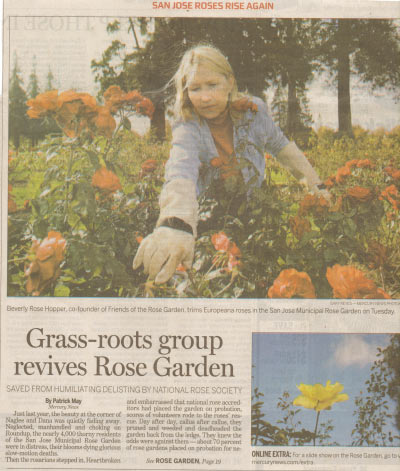Pat May, San Jose Mercury News 12/3/08
Just last year, the beauty at the corner of Naglee and Dana was quietly fading away. Neglected, manhandled and choking on Roundup, the nearly 4,000 thorny residents of the San Jose Municipal Rose Garden were in distress, their blooms dying glorious slow-motion deaths.
Then the rosarians stepped in. Heartbroken and embarrassed that national rose accreditors had placed the garden on probation, scores of volunteers rode to the roses’ rescue. Day after day, callus after callus, they pruned and weeded and deadheaded the garden back from the ledge. They knew the odds were against them — about 70 percent of rose gardens placed on probation for neglect never recover.
This week, liberation came to full flower. In a ceremony Tuesday night in San Francisco, the rose garden was officially let out of the doghouse by the board of the All-America Rose Selections, the arbiters of good grooming for public rose gardens across the United States.
“The volunteers were phenomenal,” said Tom Carruth, group president and hybridizer extraordinaire. “San Jose really stepped up, and the community obviously valued that garden and didn’t want to see it go away. I’ve never seen involvement like this before.”
City-citizen effort
But the story transcends slapped backs and a pretty plaque. For starters, coming off probation means the garden returns to the public-garden list, eligible once more for free award-winning
hybrids a year before they become available to the hoi polloi — a big deal for rose-lovers. Even more, the rescue operation was a tour de force in grass-roots organizing, powerful proof of what city-citizen collaboration can accomplish.
“Not only did we turn this garden around and restore it to the jewel that it is,” said Beverly Rose Hopper, co-founder of the Friends of the San Jose Rose Garden. “But our volunteer campaign and teamwork with the city will be used as a template nationwide.”
Due to a nasty mix of park department staffing cuts, ill-advised use of the weedkiller Roundup and general civic apathy, the declining quality of the plants led to its 2005 probationary status, a black eye that wasn’t made public until 2007. By then, cutbacks had left the park in shambles, with weeds growing higher than the roses.
“It’s one thing for neighbors to say your park’s in bad shape,” said Friends’ co-founder Terry Reilly. “But for a nationally recognized group to say it is just awful.”
Adds Hopper: “The garden had hit rock bottom. Something had to be done to save it.”
No excuses
Together, Reilly and Hopper ignited a blaze of community activism — city leaders began exploring public-private partnerships to fill park-staffing gaps; the new Friends group formally adopted the garden; and new management at City Hall warmly greeted their ideas, said Reilly, instead of “excuses on why it can’t be done.”
They grabbed organizing tools from every quarter: posting rose-pruning videos on YouTube, e-mailing a PDF newsletter to 500 homes and setting up a PayPal account for online donations. They trained an elite group of Master Volunteers (“wearing special vests so people passing by won’t think they’re just running around with shears,” said Hopper) and used everything from Eagle-Scout elbow grease to catchy marketing slogans to whip the roses into shape.
By the beginning of this year, the efforts had translated into cleaner plots and fatter blooms, leaving the garden looking like it had been hand-colored by Carmen Miranda with a box of Crayolas.
But more than anything, what Reilly and Hopper had really done was light a fire under scores of volunteer rose-lovers like Harry Garcia. A 65-year-old Willow Glen resident and avid gardener, Garcia had worked for years as a teacher for disabled students before retiring last June.
“I started volunteering the day school ended,” he says. “I love roses. It’s like there’s perfumed air around you. Being near them gives me something to get up for each morning.”
For Melissa
Garcia’s story captures the love that this rose garden, despite intermittent lapses, has embodied ever since its groundbreaking in 1931. He’s out there every day for Melissa, his oldest daughter, who died June 6, 1995, from complications from lupus. She was 18, and despite receiving her dad’s transplanted kidney, “the best doctors in the world couldn’t save her.
“I think about Melissa when I’m out there,” Garcia said this week. “She was the only one of my kids who really helped me in my garden at home. She was always right there next to me as a little girl — back when I was taking care of my own roses.”



